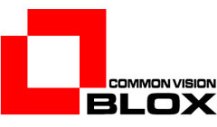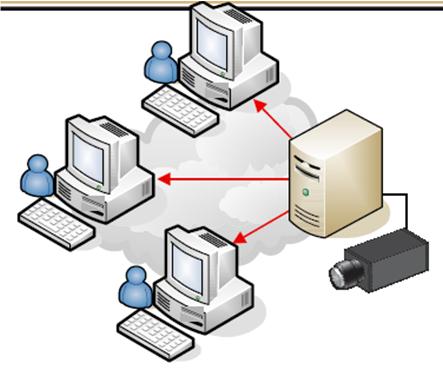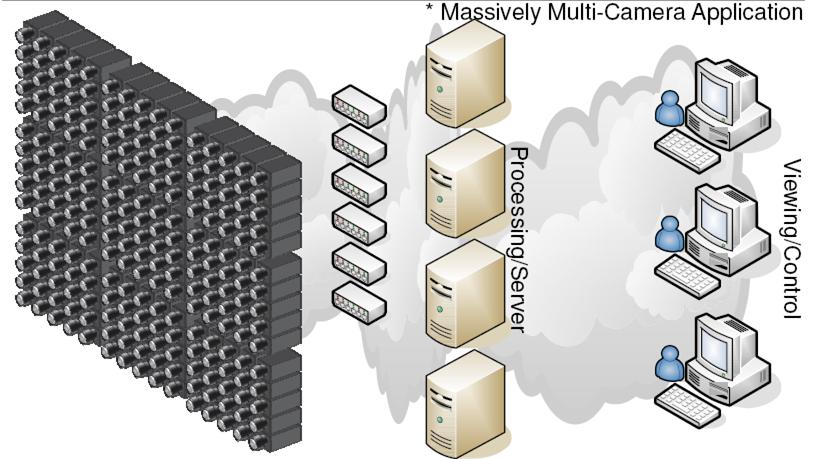|
||||||||||||||||||||||||||||||||||||||||||
|
||||||||||||||||||||||||||||||||||||||||||
GigE Vision Server Explained
 PCs acting as cameras
PCs acting as cameras
When people talk about software for GigE Vision cameras they are usually referring to the drivers required for image capture. STEMMER IMAGING have taken a different approach by integrating a GigE Vision Server into its Common Vision Blox programming library.
Once GigE Vision Server is installed, it can make the PC behave like a complete GigE Vision and GenICam compatible camera, with freely configurable features, while CVB retains all of its built-in hardware independence. It enables a PC to send any data whatsoever in a format that complies to GigE Vision. The output data from the GigE Vision Server is fully compliant with the GigE Vision standard and is therefore compatible with any standards-compliant software interfaces from other providers. GigE Vision Server opens up new opportunities in machine vision. In its simplest form, images can be transferred from a hard disk, system memory or from any CVB-compatible acquisition hardware via the network interface - thus benefiting from simplified Ethernet cabling technology. As a result, GigE Vision cameras can be simulated with all CVB-compatible acquisition technologies.
The computer behaves like a camera?
The whole approach with the GigE Vision Server is that it behaves exactly like a genuine GigE Vision camera. It is irrelevant to the processing computer whether it sees a real camera on the network as the image source or whether an image server simulates a camera. The only important thing is that the necessary image data and properties are provided reliably and in a GigE Vision compatible format. In this scenario, the user defines which camera properties are passed via the GigE Vision Server and which other properties the camera has. This allows the results of processing – such as the scanned batch numbers etc – to be provided in parallel with the image.
How do users benefit from this concept?
The camera that has been simulated on the GigE Vision Server is fully compatible with all GigE Vision-compatible software solutions on the processing computer. This means that the software solution on the processing computer does not know that it may be receiving images which have already been pre-processed or stored. To the software solution, the image server appears like a normal camera with its individual properties. Within the GigE Vision Server, developers are free to define which properties the simulated camera on the image server will provide. Using the GigE Vision standard, the simulated camera communicates the properties to the receiver so that they can be used immediately, without further adaptation.
Let us assume that it is necessary to acquire images of components with punched marks that could occur in different places, and that this mark must then be read using CVB Manto running on the image server. The software solution on the evaluation computer knows the expected position of the mark for that particular part via communications with the plant control unit. In this case, it is best for the simulated camera to provide the image server with a definable area of interest (AOI) as a property in order to read the specific mark on the component. A property is also required (as a string), to return the content of the mark that has been read on the image server. Other properties to control pre-processing or to transfer additional information between the image server and the software solution on the receiver side are possible and would be simple to implement.
What knowledge does the GigE Vision Server require of users?
Since the GigE Vision Server is part of the CVB machine vision library, users should to be able to cope with one of the normal development environments but they definitely do not need to be experts in image processing algorithms or network communications. The necessary expert knowledge is integrated into the libraries.
The GigE Vision Server supports distributed computing via full multicast server solutions. What advantages does this offer?
 The multicast solution enables images from any simulated camera –
that is the source PC – to be sent directly to several specific
receiver PCs. This for example, supports real distributed computing with
minimum network load.
The multicast solution enables images from any simulated camera –
that is the source PC – to be sent directly to several specific
receiver PCs. This for example, supports real distributed computing with
minimum network load.
In a specific case that we recently implemented, five PCs equipped with the GigE Vision Server operated as a smart video switch which then passed image data from 250 GigE Vision cameras to seven additional PCs. Each of these seven PCs was able display data from up to three cameras on the network. To achieve this, the five server computers use multicast mode to transfer data in parallel to several computers.
Aren't there already similar concepts from other vendors?
Of course PCs are already being used as image servers in some machine vision solutions. But these invariably use proprietary protocols and data formats in the course of the transfer, synchronisation and control. In these situations the image source and the image receiver need to use the same proprietary format and must be harmonised exactly with each other. Users cannot benefit from hardware or software independence in any way. It is this independence that our solution provides. As our solution is based on the GigE Vision standard, it is even possible to switch between a real camera and the image server with its simulated camera without difficulty, as long as both cameras only deliver the required properties.

Moreover, all communications between the image server and the processing computer take place exclusively via the standard GigE Vision format – without proprietary protocols or additional cabling. All that is required between the image server and the evaluation computer is a Gigabit Ethernet connection. This means that cable length problems are finally a thing of the past – particularly when using affordable glass fibre network technology.
Adept Electronic Solutions are 'The Machine Vision and Imaging Specialists' and exclusive distributor for Dalsa products in Australia and New Zealand. To find out more about Dual Line Scan please email us at: adept@adept.net.au, call us at Perth (08) 92425411 / Sydney (02) 99792599 / Melbourne (03) 95555621 or use our online contact us form.
|
If you like this page, please recommend and share it. |
|||
| More | |||



